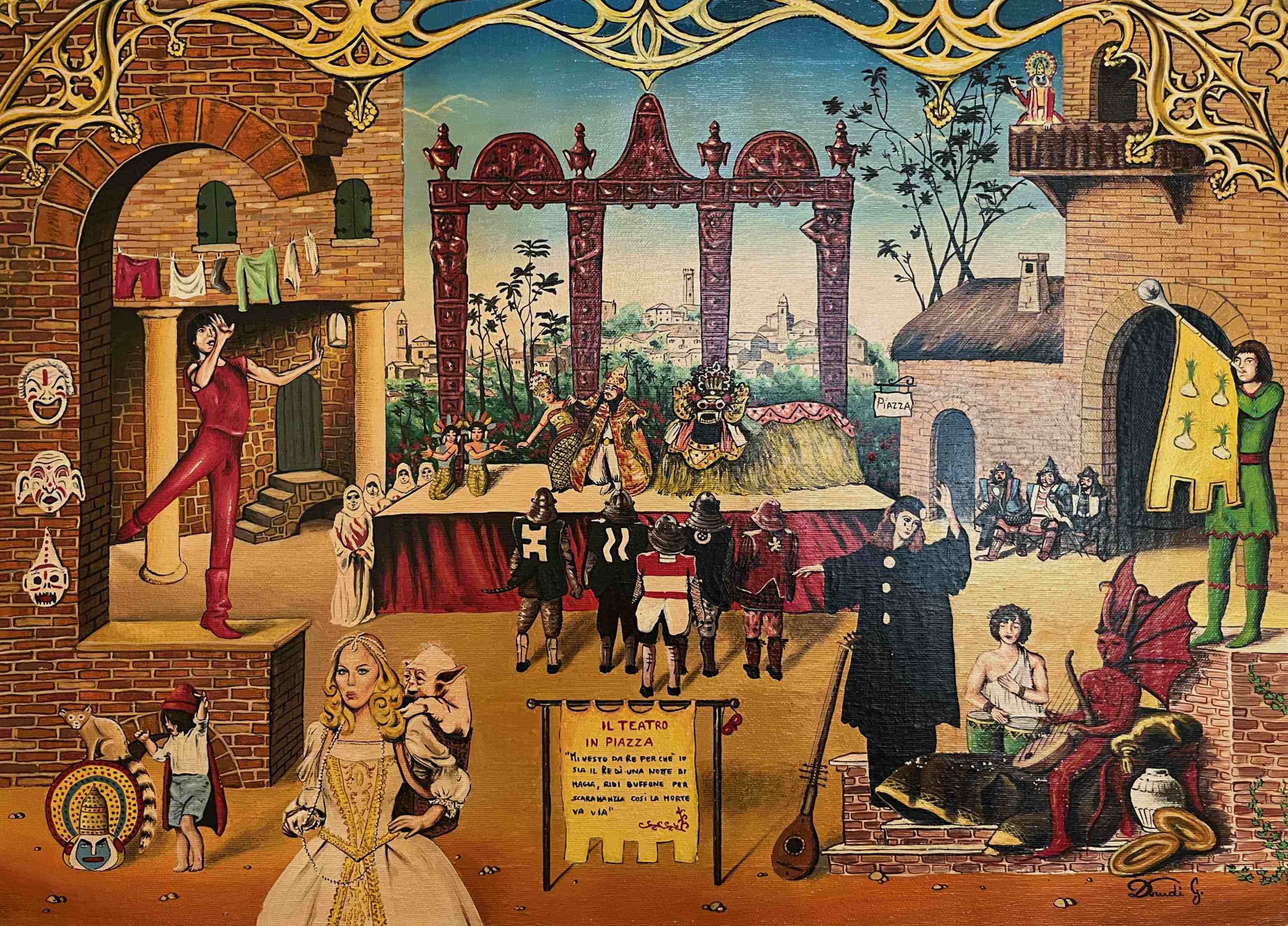THEATER IN THE SQUARE
1978, 50x70cm, Glossy oil on canvas

Santarcangelo di Romagna (Italy) is the town where the Theater in the Square takes place every summer. These theatrical characters of various origins invite the audience to follow them to the stage. A great celebration of colors and beauty. In the background, the town of Santarcangelo di Romagna.
The work “Theater in the Square,” created in 1978 with glossy oil on canvas, is a vivid and detailed celebration of the famous Theater in the Square Festival of Santarcangelo di Romagna. Every summer, this village comes alive with shows and performances, transforming its squares into an open stage, where artists of different origins and traditions involve the audience in a unique theatrical experience.
A scene of celebration and theatricality:
The work is a true explosion of colors and movement, rich in masked characters, sumptuous costumes, and architectural details that evoke a magical and fairy-tale atmosphere. The composition is structured in different narrative levels:
- At the center, the large stage with elaborate scenography hosts a theatrical representation with carnival tones, with actors in historical costumes and expressive masks that capture the attention of the spectators.
- In the foreground, a crowd of jesters, ladies, knights, and mythological figures moves between the audience and the scene, creating a bridge between the real world and that of theatrical fiction.
- On the left, a young artist in red dances on a balcony, while next to him, theatrical masks hung on the wall seem to observe the scene with enigmatic expressions.
- On the right, a herald in green with a golden banner announces the beginning of the show, while a red devil sits on a throne, surrounded by musical instruments and coins, perhaps a symbol of temptation and excess that often mix with the joy of theater.
A celebrating village:
In the background, the hilly landscape of Santarcangelo di Romagna serves as a backdrop to the entire composition, reminding the viewer of the historicity of the place and the link between art and territory. The architecture of the village, with its brick houses, arches, and medieval towers, integrates perfectly with the theatrical setting, creating a contrast between reality and representation.
An invitation to the magic of theater:
At the center of the work, a scroll with the inscription “The Theater in the Square” contains a fragment of text that invites the audience to join the magic of the show. This poetic message underlines the power of theater to transport spectators on an exciting journey, beyond physical and temporal boundaries.
Conclusion:
“Theater in the Square” is a work that celebrates art as a collective experience, uniting past, present, reality, and fantasy. With its detailed style and refined technique, the painting returns the soul of the Santarcangelo Festival, transforming the canvas into an eternal stage, where theater continues to live every time the gaze falls upon it.

Santarcangelo di Romagna (Italy) is the town where the Theater in the Square takes place every summer. These theatrical characters of various origins invite the audience to follow them to the stage. A great celebration of colors and beauty. In the background, the town of Santarcangelo di Romagna.
The work “Theater in the Square,” created in 1978 with glossy oil on canvas, is a vivid and detailed celebration of the famous Theater in the Square Festival of Santarcangelo di Romagna. Every summer, this village comes alive with shows and performances, transforming its squares into an open stage, where artists of different origins and traditions involve the audience in a unique theatrical experience.
A scene of celebration and theatricality:
The work is a true explosion of colors and movement, rich in masked characters, sumptuous costumes, and architectural details that evoke a magical and fairy-tale atmosphere. The composition is structured in different narrative levels:
- At the center, the large stage with elaborate scenography hosts a theatrical representation with carnival tones, with actors in historical costumes and expressive masks that capture the attention of the spectators.
- In the foreground, a crowd of jesters, ladies, knights, and mythological figures moves between the audience and the scene, creating a bridge between the real world and that of theatrical fiction.
- On the left, a young artist in red dances on a balcony, while next to him, theatrical masks hung on the wall seem to observe the scene with enigmatic expressions.
- On the right, a herald in green with a golden banner announces the beginning of the show, while a red devil sits on a throne, surrounded by musical instruments and coins, perhaps a symbol of temptation and excess that often mix with the joy of theater.
A celebrating village:
In the background, the hilly landscape of Santarcangelo di Romagna serves as a backdrop to the entire composition, reminding the viewer of the historicity of the place and the link between art and territory. The architecture of the village, with its brick houses, arches, and medieval towers, integrates perfectly with the theatrical setting, creating a contrast between reality and representation.
An invitation to the magic of theater:
At the center of the work, a scroll with the inscription “The Theater in the Square” contains a fragment of text that invites the audience to join the magic of the show. This poetic message underlines the power of theater to transport spectators on an exciting journey, beyond physical and temporal boundaries.
Conclusion:
“Theater in the Square” is a work that celebrates art as a collective experience, uniting past, present, reality, and fantasy. With its detailed style and refined technique, the painting returns the soul of the Santarcangelo Festival, transforming the canvas into an eternal stage, where theater continues to live every time the gaze falls upon it.